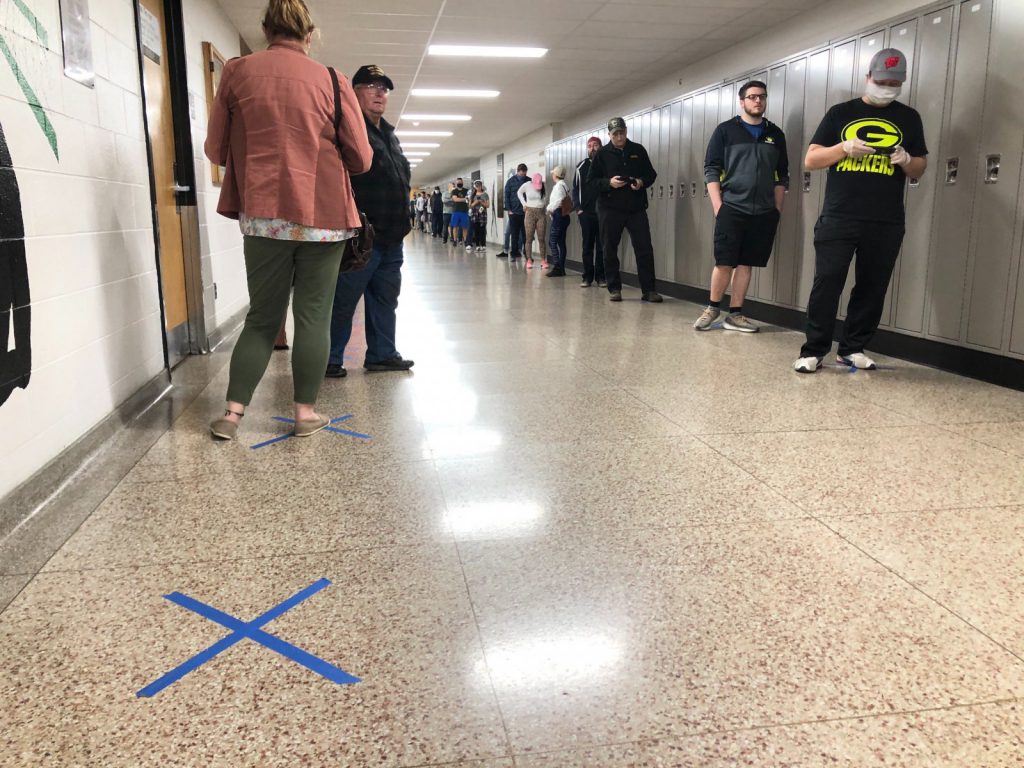Why Does Madison Have More Voting Sites Than Milwaukee?
It's less than half the size, but has 13 times the voting sites and three times the workforce.
The City of Madison has less than half the residents of the City of Milwaukee, so it stands to reason the number of polling places should be proportional as well.
And in a non-pandemic world, that would be true. Milwaukee planned to operate 180 locations for its 594,833 residents, Madison planned for 92 for its 233,209 residents.
But the reality is much different. Milwaukee is operating five large “voting centers” for the April 7th Spring Election while Madison is operating 66 polling sites.
Milwaukee Election Commission Executive Director Neil Albrecht said the spread of COVID-19 is to blame. “Right now one of the most notable differences is the number of COVID-19 cases,” said Albrecht. “Milwaukeeans, and our election workers in particular, were very alarmed by the rapid increase in cases we were seeing and deaths.”
The City of Milwaukee alone has over 1,100 cases of COVID-19 while all of Dane County has 303 cases.
“I believe we lost a significant number more election workers overall than Madison,” said Albrecht. Milwaukee is down approximately 1,000 workers from the 1,400 Albrecht wanted to have. Over 50 percent of the city’s 1,800 worker roster is over the age of 60.
But unlike Milwaukee, where Mayor Tom Barrett held a press conference on March 15th asking for more poll workers, Madison managed to find more workers. Witzel-Behl tweeted Tuesday morning that the city had 1,400 poll workers, even though 1,761 poll workers on its roster had declined to work.
Madison pays its poll workers $13.62 an hour, which works out to $102.15 for a seven-and-half hour shift or $204.50 for the whole day. Milwaukee workers are paid a $130 flat fee for a full-day shift.
“I wish I could have opened more. I wish I could have committed to more,” said Albrecht. “I did not want to stretch resources too thin by opening a lot of centers.” Early last week he said the city hoped to have “10 to 12” voting sites. Albrecht said he was grateful for the support of the 170 members of the Wisconsin National Guard helping Milwaukee’s poll workers, but characterized Governor Tony Evers order as “too little, too late.” The city didn’t find out how many would be available until yesterday despite requesting the support three weeks ago. The city had originally requested 500 members to support the election, but Milwaukee County as a whole received only 264 members. In Dane County 250 National Guard members were mobilized.
Milwaukee polling sites have seen wait times in excess of two-and-a-half hours and long lines can be spotted at every site.
Albrecht is happy with how clean Milwaukee’s polling sites are, even though there are only five. “I am 100 percent confident that you are safer than when you go into a grocery store when you go to one of the voting centers to vote in this election,” he said. Madison polling places have plastic barriers between voters and workers. Milwaukee workers wear masks and frequently wipe down surfaces.
Madison, like Milwaukee, also canceled its early voting locations and switched to a drive-up voting model for early voting. Both offered curbside voting as an option on election day for those that are ill or vulnerable.
But far more Madison voters requested absentee ballots on a per capita basis. Despite having less than half the residents, Madison voters requested 87,237 absentee ballots. Approximately 100,000 Milwaukee voters requested absentee ballots.
Witzel-Behl said turnout at 4:00 p.m. was 24.69 percent versus 43.32 percent at the same time in April 2016. Albrecht said that data wasn’t available, but turnout appeared to be “very robust.”
For more on the issue affecting cities areas across Wisconsin, see “Pandemic Decimates Urban Polling Places.”
If you think stories like this are important, become a member of Urban Milwaukee and help support real, independent journalism. Plus you get some cool added benefits.
More about the 2020 Spring Primary
- Why Don Natzke Couldn’t Vote - Enjoyiana Nururdin - Aug 9th, 2020
- Centers for Disease Control and Prevention’s Morbidity and Mortality Weekly Report highlights public health measures taken by the Milwaukee Health and Fire Departments, Department of Administration, Election Commission, and the Wisconsin Department of Health Services - City of Milwaukee Health Department - Aug 4th, 2020
- CDC Says Election Did Not Cause COVID-19 Spike - Erik Gunn - Aug 4th, 2020
- Pandemic Reduced Black Vote, Study Finds - Dee J. Hall - Jun 25th, 2020
- Did April Election Hike COVID-19 Cases? - Alana Watson - May 20th, 2020
- Elections Commission Notes ‘Lessons Learned’ - Henry Redman - May 19th, 2020
- Wisconsin Elections News: WEC Releases Analysis of Absentee Voting in April 7 Spring Election - Wisconsin Elections Commission - May 18th, 2020
- Election’s Impact on County’s COVID-19 Cases Unclear - Jeramey Jannene - May 6th, 2020
- Why State’s Voting By Mail Was Chaotic - Daniel C. Vock - May 4th, 2020
- At Least 40 COVID-19 Cases Tied to Election in Milwaukee - Graham Kilmer - Apr 24th, 2020
Read more about 2020 Spring Primary here






















